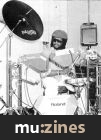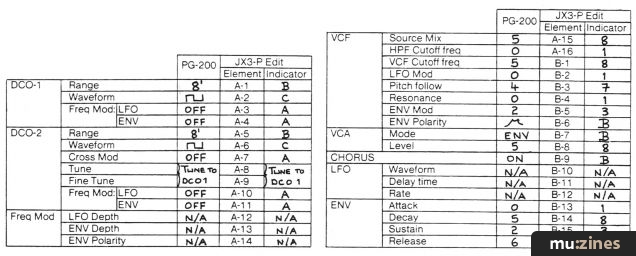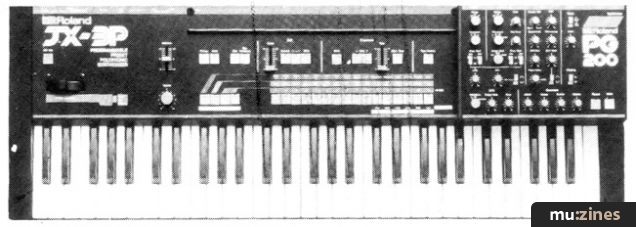Magazine Archive
Home -> Magazines -> Issues -> Articles in this issue -> View
Article Group: | |
The Six-String Synthesizer | |
Article from International Musician & Recording World, February 1985 | |
Mark Wood of Nucleus and Sunwind talks about the amazing possibilities of the new GR-700, and reveals how you can use it to play two separate and independent instrument parts at the same time.

Mark Wood has been a guitar synthesizer man just about as long as it's been possible. He worked on film scores and recording sessions with the original Roland GR-500 system, bought the simpler but more user friendly GR-300 system as soon as it came on to the market, and has pioneered the creative use of the GR-700 system with its adventurous guitar controller and keyboard-synth sound potential.
'Right from the start' he comments 'The aim was to front a band based around the unique possibilities of guitar synthesis. I have usually worked with the basic line-up of guitar-synth, bass and drums perhaps with horns and vocals on top of that. But the guitar synthesizer took the place of a keyboard player and wherever I have worked with keyboard players it's been on an understanding that the sound was still based around what a guitar synthesizer can do. With the GR-300 I used to process the synthesizer a great deal, putting the sound through a rack with digital delays and so on to get the effects I needed. With the GR-700 the instrument is capable of a complete keyboard role in its own right—and more!
'The first time I put the GR-700 through its paces we were doing a series of gigs in South America — a real baptism of fire. I discovered the sounds as I went along. The GR-700 has really good strings presets and also great chime and organ presets. With lead sounds I tended to develop my own instead of using the presets — I would just find a sound I liked, load it into the RAM cartridge for future use. After a couple of weeks I had three or four cartridges full of sounds. It's very important to explore the GR-700 — there is far more to it than just a collection of presets.'

How to play guitar with your feet!
Mark has always made a point of exploiting the ability of the guitar synthesizer to 'double up' as either a lead instrument or a chord/layering instrument. This has been essential to the structure of the music he has played on the Guitar Synthesizer. With an instrument this powerful and this versatile you have to write for it. A common mistake people make is just trying to do the same things on the guitar synth you used to do on the guitar. Naturally, that doesn't always work.
What usually happens then is people come to me and complain about the 'triggering'. The fact is that a lot of sounds don't trigger like guitar sounds because the structure and the envelope isn't the same. Play a fast scale with a string voice on which the attack is very slow, and the result is fairly predictable. What I always tell them is — it takes you two years before you can get a reasonable sound out of a flute or a violin at all, now here's an instrument that will give you those sounds on a plate and you complain that it takes an hour or so to adjust to working with them!'
Mark, writing specifically for the sounds within the GR-700, creates music that is appropriate to the sounds he chooses and adapts his technique accordingly. But he has discovered that the GR-700 offers more than just variety. It offers, for example, the ability to play different musical parts simultaneous on the one instrument. Here's how it works.
'I began by developing the technique of blending the guitar sound with a brass sound on one or two strings only — perhaps playing a melody on one string and fitting the guitar around it chordally. The next step is to exploit the fact that the pitch of DCO-2 can be programmed into a patch. You keep the Hold pedal down and programme a chord into, for example, Bank 7 Patch 1, and then using the tuning facility on DCO-2 you can put the same chord into Bank 7 Patch 2 transposing it a semitone higher, and then Bank 7 Patch 3 can be a tone higher, and so on in whatever sequence you want. Of course, all the patch changes are made by footswitches on the module so you can simply play the chord changes with your feet! If the straight guitar is then processed through a separate amplification system or a separate input on the desk you can then play the guitar over the foot-controlled chord sequence — two instruments at once. Of course, that's only the start — you can experiment with changing the sounds as well as the pitch of the chords, you can bring DCO-1 in again to get different harmonies which aren't just in parallel motion — all kinds of things. And when you start getting into MIDI and an additional two or three synthesizers going at the same time, well...'
MIDI is, in fact, Mark Wood's next project for his by now well played-in GR-700 system. He has discovered many little tricks with the system similar to the one outlined above but feels the GR-700 has many more up its sleeve. 'The most important thing is to learn to stop thinking of the GR-700 as just one instrument and especially to get beyond just treating it like an electric guitar with extra sounds. That way you don't scratch the surface of what it can do. I find you have to assume a different persona — put on a different hat — for each different voice you use. The guitarist has to learn to cope with this immense capability and has to learn, as keyboard players already have, how to handle an infinite number of different sounds and musical structures from one fingerboard.'

Mark Wood demonstrated the Roland GR-700 Guitar Synthesizer to thousands of interested musicians at the recent series of Roland Road Shows. The set-up he used to play lead and rhythm parts simultaneously and to make the most of the GR-700’s sophisticated synthesizer circuitry is shown here in detail.
More with this topic
 Barnacle's Synth Sax |
Back to Back |
Back to Back |
Trends In Pop & Rock Since The Birth Of A1 Music |
Designs On The Future |
Drum Role - An application guide to Roland electronic percussion |
EP-50 - 76-Key MIDI Piano |
Step By Step |
Prophecies Spring 1984 - Advertisement Feature - Sequential Pullout |
Review |
Back to Back |
Step by Step |
Browse by Topic:
Advertisement Feature
Also featuring gear in this article
Exploring New Territory - Gibson Explorer Synth
(EMM Dec 85)
Gibson Explorer Synth - Guitarcheck
(IM Feb 86)
Roland GR700 Guitar Synth
(12T Apr 84)
The Guitar Link
(ES Jun 84)
The Guitarist's Revenge
(EMM Jun 84)
Browse category: Guitar Synthesizer > Roland
Featuring related gear
Polyphonic Synthesizers
(ES Dec 83)
Roland JX-3P and PG-200
(MU Sep 83)
Patchwork
(EMM Jun 84)
Patchwork
(EMM Aug 84)
Patchwork
(EMM Oct 84)
Patchwork
(EMM Dec 84)
Patchwork
(EMM Mar 85)
Patchwork
(MT Feb 89)
...and 5 more Patchwork articles... (Show these)
Browse category: Synthesizer > Roland
Publisher: International Musician & Recording World - Cover Publications Ltd, Northern & Shell Ltd.
The current copyright owner/s of this content may differ from the originally published copyright notice.
More details on copyright ownership...
Roland Newslink
Feature
Help Support The Things You Love
mu:zines is the result of thousands of hours of effort, and will require many thousands more going forward to reach our goals of getting all this content online.
If you value this resource, you can support this project - it really helps!
Donations for April 2024
Issues donated this month: 0
New issues that have been donated or scanned for us this month.
Funds donated this month: £7.00
All donations and support are gratefully appreciated - thank you.
Magazines Needed - Can You Help?
Do you have any of these magazine issues?
If so, and you can donate, lend or scan them to help complete our archive, please get in touch via the Contribute page - thanks!






























